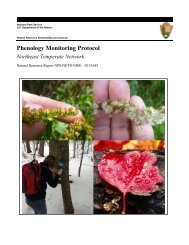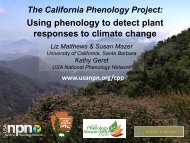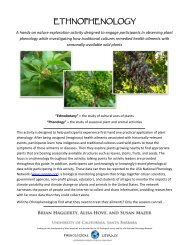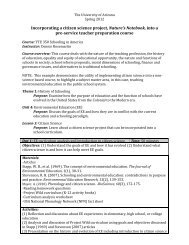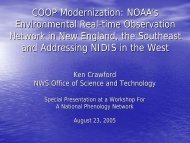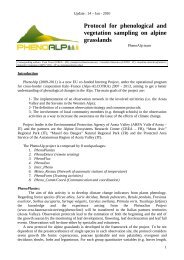The Phenology Handbook - USA National Phenology Network
The Phenology Handbook - USA National Phenology Network
The Phenology Handbook - USA National Phenology Network
You also want an ePaper? Increase the reach of your titles
YUMPU automatically turns print PDFs into web optimized ePapers that Google loves.
WHAT IS PHENOLOGY?<br />
PHENOLOGY IS THE OBSERVATION AND MEASUREMENT OF EVENTS IN TIME<br />
<strong>The</strong> passing of the seasons is one of the most familiar phenomena on Earth. Consider, for example, the onset<br />
of spring in temperate climates. As winter ends, our surroundings burst with new life — forest canopies fill with<br />
vibrant greens, flocks of birds migrate in formation to northern breeding grounds, and brilliant wildflowers and<br />
their insect pollinators appear in rapid succession across hillsides, roadsides, lake margins, and fields. Similarly,<br />
as autumn approaches, the deciduous forest canopy progresses towards a colorful demise, birds navigate their<br />
return to southern wintering grounds, mammals gorge on the summer’s bounty to prepare for their winter hibernation,<br />
and many plants ripen their last fruits before the onset of winter.<br />
Whether we live in urban or rural environments, there are constant reminders of the changing of the seasons.<br />
Many of us notice when the first wildflowers appear in the spring, when our favorite fruits are available in the<br />
local farmers’ markets or supermarket, when trees change color or lose their leaves in the fall, when wildfire risk<br />
is highest due to the drying of our forests’ fuels, or when frost first appears in the fall or winter. By studying the<br />
seasons in greater detail over the course of our lives, we can deepen our connection with, and understanding of,<br />
the landscapes we inhabit. We also develop our ability to observe and to measure the pace and the timing of the<br />
seasons, the onset and duration of which are shifting with the changing climate.<br />
Scientists refer to the study of the timing of seasonal biological activities<br />
as phenology. This term was first introduced in 1853 by the Belgian<br />
botanist Charles Morren and is derived from the Greek words phainos,<br />
meaning “to appear, to come into view” and logos, meaning “to study.”<br />
<strong>Phenology</strong> is the science that measures the timing of life cycle events in<br />
plants, animals, and microbes, and detects how the environment influences<br />
the timing of those events. In the case of flowering plants, these<br />
life cycle events, or phenophases, include leaf budburst, first flower, last<br />
flower, first ripe fruit, and leaf shedding, among others. Phenophases<br />
commonly observed in animals include molting, mating, egg-laying or<br />
birthing, fledging, emergence from hibernation, and migration.<br />
While the term seasonality is<br />
used to describe changes in the<br />
abiotic environment, such as the<br />
dates of the first and last frosts<br />
of the winter, or the date that<br />
ice melts in lakes or streams, the<br />
term phenology is reserved for<br />
describing the timing of biological<br />
activities.<br />
To characterize and to describe phenophases, phenologists record the dates that these events occur, and they<br />
study how environmental conditions such as temperature and precipitation affect their timing. In addition, phenology<br />
may incude the study of how the timing of phenophases evolves by natural selection in response to<br />
periodic environmental conditions such as winter cold, summer drought, and the emergence of pests and predators.<br />
<strong>The</strong> timing of phenological events can be quite sensitive to environmental conditions. For example, in a<br />
particularly warm and dry spring, leaf budburst and first flower might occur weeks earlier than usual, whereas in<br />
an exceptionally cool and wet spring they could be equally delayed. As a result, the timing of phenophases tends<br />
to vary among years based on patterns of weather, climate and resource availability. Phenological observations<br />
are therefore integrative measures of the condition of the physical, chemical, and biological environment. This<br />
environmental sensitivity means that phenological studies are simple and cost-effective ways to measure environmental<br />
changes, including climate change, over the long-term.<br />
2<br />
Weather is defined as the near-term atmospheric conditions of a region, such as temperature, precipitation,<br />
humidity, wind, and sunshine. <strong>The</strong> climate of a region, on the other hand, is characterized by the<br />
generally-prevailing weather conditions. For example, Santa Barbara, California is characterized by a Mediterranean<br />
climate – warm, dry summers and cool, moist winters. <strong>The</strong>re are, however, daily and weekly<br />
changes in the weather that can rapidly change the temperature, sunshine, and wind conditions.



